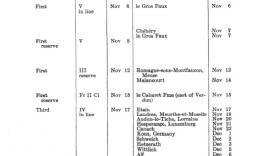In this segment, death in a farm field leads to a historic moment for the U.S. Army’s First Division a century later.
As she traced the steps of Sergeant Chester Schulz to northern France, the conversation shifted as Nancy Hasting, her sister Ann Stevenson and the WNIN crew moved closer to where the battle raged on the outskirts of Sedan in early November 1918.
The village of Chehery is where First Platoon of Company K, with Chester leading, could at last see the battle toward which they were marching. On a cold, wet morning, German troops began shooting at them.
Standing next to a busy highway, Nancy imagined what her great-uncle and the rest of the soldiers mighter have felt as they contemplated what lay ahead. “It would have been real. And, they're being pushed to move forward. From here, they know the Germans could be anywhere, so it would have been real.”
It was just after seven a.m. on November 7, 1918. Nearby, in the relative safety of the walled cemetery at Cheveuges, Company K paused to plan an attack on a German machine gun. The prospect was bleak.
Reading from a military account, Nancy related the troops' situation. “The history of the 28th Infantry (Regiment, First Division) says there was no artillery support, and all advances were accomplished by the sheer force of frontal attack. In other words, these guys with rifles in their hands. The German resistance was prepared to make a desperate stand, for the loss of these hills meant the loss of Sedan.”
Standing at the gate of the Cheuveges cemetery while reviewing an image taken in 1918, a chilling truth emerges. There is not now, nor was there a century ago, any cover on the hillside separating the cemetery from the likely location of the German machine gun. There is only a small dip in the terrain about halfway in between.
As she looked up the same hillside, Nancy said, “I’m not sure I could have done it.”
At the age of twenty six years and thirty one days, Sergeant Chester Schulz of Evansville and seven other Americans died on the hillside outside Cheveuges. I was just after eight a.m. The troops had been on the front line for less than an hour.
“I think he died fairly quickly, because of where he was buried. He didn’t live long enough to be taken to a hospital, so I think he died fairly quickly.”
Military accounts indicate the troops were pinned down all day and unable to advance. They were relieved on the evening of November 7th. For the survivors of First Platoon and Company K, the war was over.
It was March of 1919 before official word came of Chester’s death. To add insult to injury, the clerical error when Chester transferred to the First Division at Mussidan also meant that his name was left off a First Division monument at Wadlincourt, France to the casualties of that battle. Nancy couldn’t do anything about the ordeal her family suffered in 1918, but she decided to something about the monument.
She contacted First Infantry Division Memorial Association president Tom Orlowski to see if Chester’s name could be added to the Wadlincourt monument.
No one has ever asked us to add a name, so it's a pretty rare event. - Tom Orlowski, First Infantry Division Memorial Association
Orlowski said it prompted a historic discussion for the memorial association of the U.S. Army's most storied division. “No one else has asked us to add a name, so it's a pretty rare event. But anyone who gave his life, or her life in defense of this country or to advance the cause of freedom, deserves to be recognized, even if it was a century ago."
On the last day of our production in France, we met at the Wadlincourt monument with caretaker, Claude Zanette, who agreed to install a plaque with Chester's name and unit on the monument.
After nearly a century of waiting and months of work and negotiation, the plaque installation was delayed one more time, briefly, as Nancy Hasting asked to turn the last screws herself.
The plaque is an obvious addition and will no doubt prompt questions from future visitors. I asked Nancy what she would say to them.
"I would say that it's there to honor a forgotten soldier, who should have been up there with his Company K mates, and even though it didn't happen, we still care enough a hundred years later to see that he gets the recognition he deserves."
Nancy Hasting has a blog called “Tracing Chester Schulz” on Word Press, and has put the experiences of her family into a book called, “A Tragedy of the Great War” .









